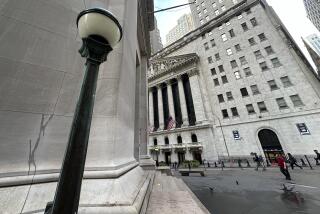What’s Ahead for Wall Street? : The Case for Stocks:
After reaching record highs in early January, the stock market has taken a tortuous turn for the worse, dragging investor sentiment down with it. Experts are divided on the market’s future course. Some believe that stock prices have hit bottom and now is the time to buy; others believe that this is just the start of a long slide. Here are the arguments on each side.
The good news is that everybody already knows the bad news. And the bad news isn’t as bad as it seems.
A number of factors, including rising interest rates and inflation, have conspired to devastate stock prices. But the market, at least in theory, anticipates events at least six months in the future. By then, many economists believe, the bad news about inflation and interest rates will have subsided.
With that scenario in mind, stocks look cheap.
Since its record high on Jan. 2, the Dow Jones industrial index has fallen by more than 100 points. Stock prices are selling at modest prices in relation to their projected earnings--less than 12 times per-share earnings, compared to more than 20 times earnings when the market was overheated. And dividend yields are now above 4%--a healthy premium over the anemic 2.5% yields when the market was due for a major correction.
“I think we’ve hit the low end of the range, and both the stock and bond markets are very attractive right now,” said Michael Metz, market strategist for Oppenheimer & Co. in New York.
Although interest rates have not fallen as far or as fast as investors had previously hoped, upward pressures on rates are diminishing, so further hikes seem unlikely.
Moreover, some analysts contend that investors have overreacted to inflation, which has jumped in recent months primarily because of one-time events such as Hurricane Hugo, the Florida freeze and the Bay Area Quake. But the impact of those events is already diminishing, and inflation will probably drop to very low levels by mid-year. Interest rates are bound to follow, moving at least slightly lower by year-end.
“In a low-inflation and low-interest-rate market, I think you will see the market driven up,” Metz said. He expects the Dow Jones industrial index to hit new highs this spring.
Other “bulls”--people who believe the stock market is headed up--think that the negatives have already been factored into stock prices but some of the ensuing positives have not.
“I just don’t see a lot of room for surprises on the downside,” said Eugene E. Peroni Jr., director of technical research for Janney Montgomery Scott in Philadelphia. “Many stocks are exhibiting bottoming signals, and I don’t think the market has made its high for the year,” he added.
Peroni expects the Dow to approach the 2,900 level before year-end, and he believes that it could move past 3,000 in the next three years.
Geraldine Weiss, editor of Investment Quality Trends in La Jolla, agrees: “On a technical basis, I see the market going higher. And on a fundamental basis, I see the reasons why investors would be attracted to buying stocks.” If the market can surpass its all-time high of 2,810, Weiss believes that it will soar into the 3,000s.
Part of the optimism has its roots in history. The stock market, over long periods of time, has outperformed most other investments. Over a 10-year period ended in 1989, for example, the Standard & Poor’s 500-stock index has appreciated by an average annual rate of 18.2%, while the yield on corporate bonds was 13.9% and real estate was up only 10.6%.
Additionally, historical market statistics indicate that stocks are not overvalued. Typically, market analysts consider stocks overvalued when dividend yields fall below 3% and when stock prices rise above 20 times projected earnings per share. Neither is the case now, which makes any new price declines look like buying opportunities to these optimists.
Market sentiment is also extremely negative, said Peter Canelo, investment strategist for Bear, Stearns & Co. Although sentiment has been climbing during the past week, still nearly half of the market experts surveyed by the Bullish Consensus in Pasadena are negative about the stock market’s future.
In the perverse world of market timing, such bad news is good news. Why? The theory is that if nearly everyone is pessimistic, the bulk of the market will have sold out by now. Smart investors would want to jump in while most are still pessimistic, because once the vast majority becomes optimistic, its usually too late to find any bargains.
Meanwhile, others believe that while the market may not stage an overall rally, certain company stocks are set for hikes simply because those individual firms are in good shape and their shares are selling at bargain prices.
Shares in companies such as Hilton--which were pounded in the past few days after the company announced that it was no longer for sale--are selling near their annual low and for less than half the 52-week high, for example. That may be an overreaction because the asset value of its hotel group is still believed to be well above the company’s recent market price of about $50 a share.
Analysts also believe that some well-positioned financial services companies and manufacturing firms are due for rallies. Blue chip stocks that were hard hit in recent market tumbles may also be positioned for gains.
“There are good values out there, but at this stage, investors should be very selective,” Weiss said. “I would think that these undervalued blue chips will lead the market.”
More to Read
Inside the business of entertainment
The Wide Shot brings you news, analysis and insights on everything from streaming wars to production — and what it all means for the future.
You may occasionally receive promotional content from the Los Angeles Times.










